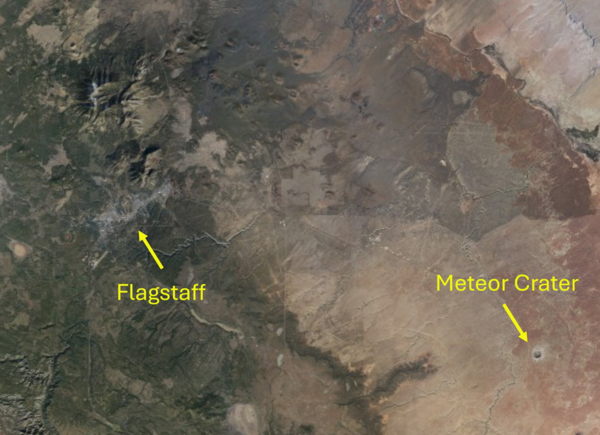NASA's Mars rover Curiosity acquired this image using its Front Hazard Avoidance Camera (Front Hazcam) on Feb. 23, 2025 — sol 4462, or Martian day 4,462 of the Mars Science Laboratory mission — at 21:43:37 UTC.
Images
Browse here for some of our available imagery. We may get permission to use some non-USGS images and these should be marked and are subject to copyright laws. USGS Astrogeology images can be freely downloaded.
NASA's Mars rover Curiosity acquired this image using its Front Hazard Avoidance Camera (Front Hazcam) on Feb. 23, 2025 — sol 4462, or Martian day 4,462 of the Mars Science Laboratory mission — at 21:43:37 UTC.
This picture of an astronaut investigating a rock on the Moon is on USGS circular 1507. The photo triggers the imagination of finding and taking advantage of resources on the Moon, to further space travel and/or work toward human goals to live beyond Earth.
This picture of an astronaut investigating a rock on the Moon is on USGS circular 1507. The photo triggers the imagination of finding and taking advantage of resources on the Moon, to further space travel and/or work toward human goals to live beyond Earth.
This picture of an astronaut investigating a rock on the Moon is on USGS circular 1507. The photo triggers the imagination of finding and taking advantage of resources on the Moon, to further space travel and/or work toward human goals to live beyond Earth.
This picture of an astronaut investigating a rock on the Moon is on USGS circular 1507. The photo triggers the imagination of finding and taking advantage of resources on the Moon, to further space travel and/or work toward human goals to live beyond Earth.
Aerial imagery showing the location of Flagstaff, Arizona and Meteor Crater. Arrows point to Flagstaff on the left and Meteor Crater on the right.
Aerial imagery showing the location of Flagstaff, Arizona and Meteor Crater. Arrows point to Flagstaff on the left and Meteor Crater on the right.
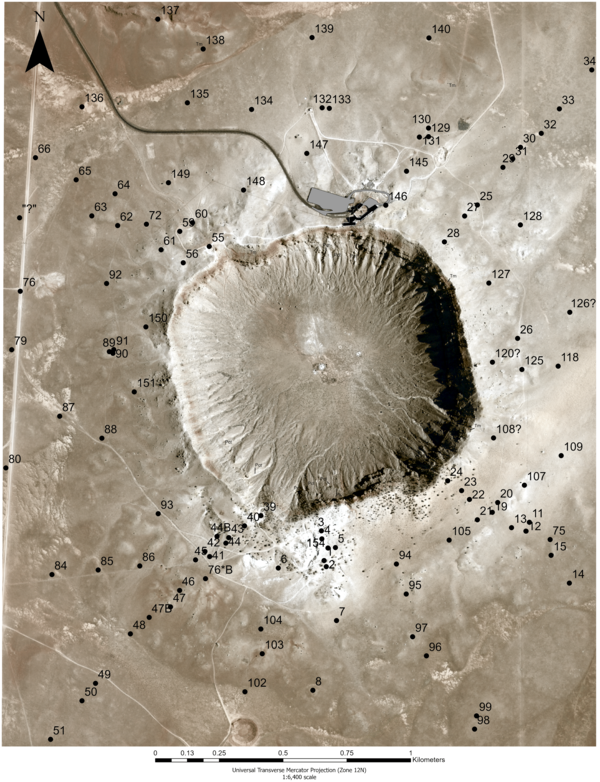
Aerial image of Meteor Crater with drill hole annotations
Aerial image of Meteor Crater with drill hole annotationsAerial image showing a plan view of Meteor Crater. Drill hole locations denoted by black dots and labeled with their respective drill hole numbers.
Aerial image of Meteor Crater with drill hole annotations
Aerial image of Meteor Crater with drill hole annotationsAerial image showing a plan view of Meteor Crater. Drill hole locations denoted by black dots and labeled with their respective drill hole numbers.

View from the floor of Meteor Crater, looking roughly to the east.
View from the floor of Meteor Crater, looking roughly to the east.Photograph taken from the floor of Meteor Crater, looking roughly east. The crater rim is visible running across the top of the image.
View from the floor of Meteor Crater, looking roughly to the east.
View from the floor of Meteor Crater, looking roughly to the east.Photograph taken from the floor of Meteor Crater, looking roughly east. The crater rim is visible running across the top of the image.
Small cardboard boxes that are used to store and archive drill cuttings from Meteor Crater.
Small cardboard boxes that are used to store and archive drill cuttings from Meteor Crater.
Sample bags of cuttings from drill hole 22. Samples were collected every one foot (0.3 meters) until reaching bedrock, depths are recorded on sample bags in feet.
Sample bags of cuttings from drill hole 22. Samples were collected every one foot (0.3 meters) until reaching bedrock, depths are recorded on sample bags in feet.
The Meteor Crater sample collection contains many samples. Some are shown here in polyethylene bags or small manilla coin envelopes with rock fragments and powdered material. The collection is stored in large boxes (also shown).
The Meteor Crater sample collection contains many samples. Some are shown here in polyethylene bags or small manilla coin envelopes with rock fragments and powdered material. The collection is stored in large boxes (also shown).
Small fragments of dark, glassy impact melt particles from Meteor Crater, and larger, white shock-melted Coconino sandstone.
Small fragments of dark, glassy impact melt particles from Meteor Crater, and larger, white shock-melted Coconino sandstone.
This is a group photo of members of the U.S. Geological Survey Open House team from the Astrogeology Science Center; Arizona Water Science Center; Southwest Biological Science Center; Geology, Minerals, Energy, Geophysics Science Center; and Western Geographic Science Center.
This is a group photo of members of the U.S. Geological Survey Open House team from the Astrogeology Science Center; Arizona Water Science Center; Southwest Biological Science Center; Geology, Minerals, Energy, Geophysics Science Center; and Western Geographic Science Center.
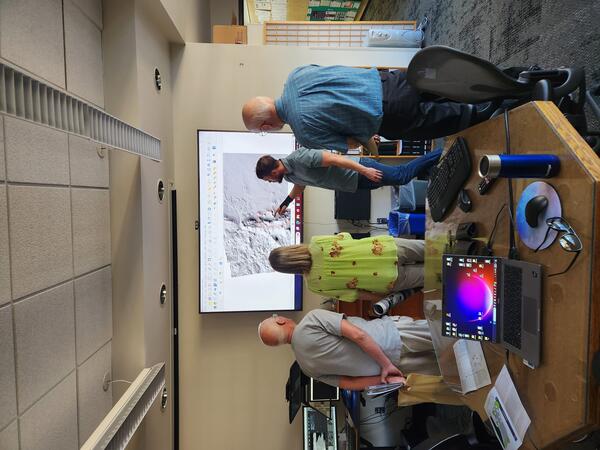
A USGS cartographer discusses planetary geology with the public
A USGS cartographer discusses planetary geology with the publicUSGS cartographer Ben Wheeler discusses planetary geology with the public in the Photogrammetry Lab at the Astrogeology building on the Flagstaff USGS science campus, during an Open House.
A USGS cartographer discusses planetary geology with the public
A USGS cartographer discusses planetary geology with the publicUSGS cartographer Ben Wheeler discusses planetary geology with the public in the Photogrammetry Lab at the Astrogeology building on the Flagstaff USGS science campus, during an Open House.
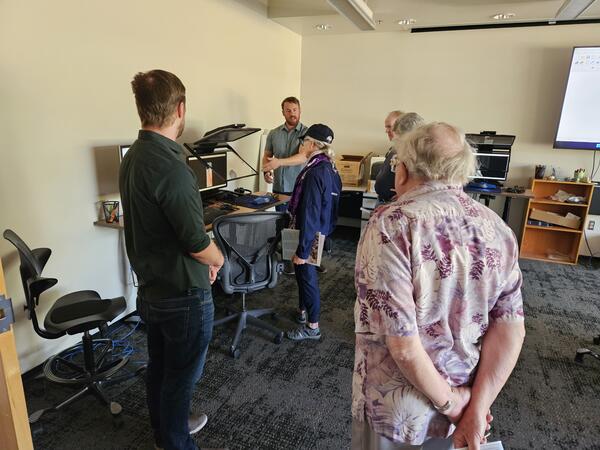
A USGS cartographer engages with the public in the Photogrammetry Lab at the Flagstaff USGS Open House
A USGS cartographer engages with the public in the Photogrammetry Lab at the Flagstaff USGS Open HouseUSGS cartographer Ben Wheeler engages with the public in the Photogrammetry Lab in the Astrogeology building at the 2024 USGS Flagstaff Open House. Photo by Lori Pigue, USGS.
A USGS cartographer engages with the public in the Photogrammetry Lab at the Flagstaff USGS Open House
A USGS cartographer engages with the public in the Photogrammetry Lab at the Flagstaff USGS Open HouseUSGS cartographer Ben Wheeler engages with the public in the Photogrammetry Lab in the Astrogeology building at the 2024 USGS Flagstaff Open House. Photo by Lori Pigue, USGS.
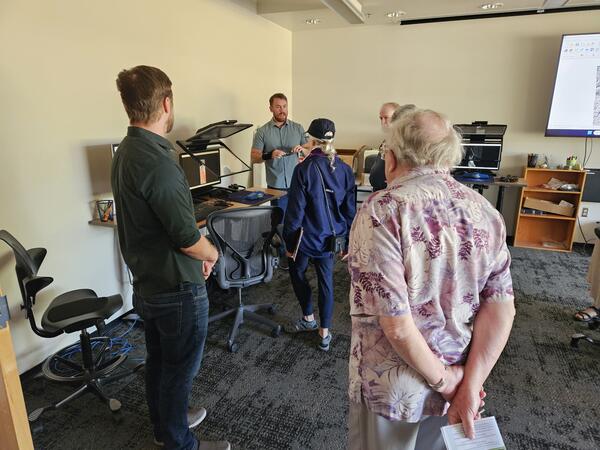
A USGS cartographer engages with the public in the Photogrammetry Lab at the USGS Flagstaff Open House
A USGS cartographer engages with the public in the Photogrammetry Lab at the USGS Flagstaff Open HouseUSGS cartographer Ben Wheeler engages with the public in the Photogrammetry Lab in the Astrogeology building at the 2024 USGS Flagstaff Open House. Photo by Lori Pigue, USGS.
A USGS cartographer engages with the public in the Photogrammetry Lab at the USGS Flagstaff Open House
A USGS cartographer engages with the public in the Photogrammetry Lab at the USGS Flagstaff Open HouseUSGS cartographer Ben Wheeler engages with the public in the Photogrammetry Lab in the Astrogeology building at the 2024 USGS Flagstaff Open House. Photo by Lori Pigue, USGS.
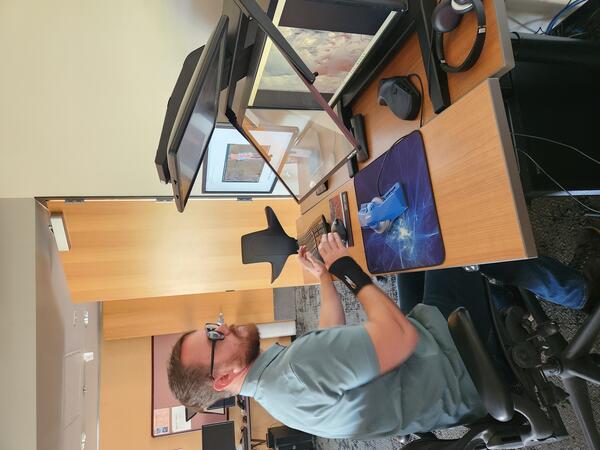
A USGS cartographer works in the Astrogeology Photogrammetry Lab
A USGS cartographer works in the Astrogeology Photogrammetry LabUSGS cartographer Ben Wheeler works in the Astrogeology Photogrammetry Lab at the USGS Flagstaff science campus.
A USGS cartographer works in the Astrogeology Photogrammetry Lab
A USGS cartographer works in the Astrogeology Photogrammetry LabUSGS cartographer Ben Wheeler works in the Astrogeology Photogrammetry Lab at the USGS Flagstaff science campus.

Using Machine Learning and Artificial Intelligence to Find Outliers in Curiosity Rover's ChemCam Data
Using Machine Learning and Artificial Intelligence to Find Outliers in Curiosity Rover's ChemCam DataOblique view of Gale crater, Mars, annotated with the Curiosity rover's traverse. Inset images show targets identified as outliers in ChemCam data using a machine learning algorithm developed by REU student Liberty Mallison.
Using Machine Learning and Artificial Intelligence to Find Outliers in Curiosity Rover's ChemCam Data
Using Machine Learning and Artificial Intelligence to Find Outliers in Curiosity Rover's ChemCam DataOblique view of Gale crater, Mars, annotated with the Curiosity rover's traverse. Inset images show targets identified as outliers in ChemCam data using a machine learning algorithm developed by REU student Liberty Mallison.
This image was taken by the NASA Mars curiosity rover on sol 4251 by the front hazcam.
This image was taken by the NASA Mars curiosity rover on sol 4251 by the front hazcam.
The Apollo 11 Traverses (left) did not travel more than ~1/10th of a mile from the LEM. The Apollo 17 Traverses (base image), on the other hand, traveled 22.2 miles in Grover. This map illustrates the difference in scale between the two missions. Photo Credit: NASA/GFSC/ASU, USGS Astrogeology
The Apollo 11 Traverses (left) did not travel more than ~1/10th of a mile from the LEM. The Apollo 17 Traverses (base image), on the other hand, traveled 22.2 miles in Grover. This map illustrates the difference in scale between the two missions. Photo Credit: NASA/GFSC/ASU, USGS Astrogeology

Example of nested mapping scales at the Apollo 17 landing site
Example of nested mapping scales at the Apollo 17 landing siteThe nested quality of USGS IMAP 800 is exemplified in this image. The inset of the 1:50K (smaller area, larger scale) landing site map is outlined on the 1:250K (larger area, smaller scale) map of the Taurus Littrow area. Photo Credit: USGS Astrogeology
Example of nested mapping scales at the Apollo 17 landing site
Example of nested mapping scales at the Apollo 17 landing siteThe nested quality of USGS IMAP 800 is exemplified in this image. The inset of the 1:50K (smaller area, larger scale) landing site map is outlined on the 1:250K (larger area, smaller scale) map of the Taurus Littrow area. Photo Credit: USGS Astrogeology
GOES-West image of the explosive eruption of the Hunga Tonga volcano in 2022. The explosion atmospheric pressure waves that traveled around the world. Read more here.
GOES-West image of the explosive eruption of the Hunga Tonga volcano in 2022. The explosion atmospheric pressure waves that traveled around the world. Read more here.

Lunar Reconnaissance Orbiter Camera Mosaic of Gruithuisen Domes
Lunar Reconnaissance Orbiter Camera Mosaic of Gruithuisen DomesLunar Reconnaissance Orbiter Camera (LROC) mosaic of the Gruithuisen (pronounced “groot-high-sen”) domes on the Moon. These unusual high-silica volcanic features are the target of the NASA Lunar Vulkan Imaging Spectroscopy Explorer (Lunar-VISE) mission. USGS scientist Kristen Bennett is a member of the Lunar-VISE science team.
Lunar Reconnaissance Orbiter Camera Mosaic of Gruithuisen Domes
Lunar Reconnaissance Orbiter Camera Mosaic of Gruithuisen DomesLunar Reconnaissance Orbiter Camera (LROC) mosaic of the Gruithuisen (pronounced “groot-high-sen”) domes on the Moon. These unusual high-silica volcanic features are the target of the NASA Lunar Vulkan Imaging Spectroscopy Explorer (Lunar-VISE) mission. USGS scientist Kristen Bennett is a member of the Lunar-VISE science team.





